A mathematical model for LH release in response to continuous and pulsatile exposure of gonadotrophs to GnRH
- PMID: 15447787
- PMCID: PMC524191
- DOI: 10.1186/1742-4682-1-9
A mathematical model for LH release in response to continuous and pulsatile exposure of gonadotrophs to GnRH
Abstract
In a previous study, a model was developed to investigate the release of luteinizing hormone (LH) from pituitary cells in response to a short pulse of gonadotropin-releasing hormone (GnRH). The model included: binding of GnRH to its receptor (R), dimerization and internalization of the hormone receptor complex, interaction with a G protein, production of inositol 1,4,5-trisphosphate (IP3), release of calcium from the endoplasmic reticulum (ER), entrance of calcium into the cytosol via voltage gated membrane channels, pumping of calcium out of the cytosol via membrane and ER pumps, and release of LH. The extended model, presented in this paper, also includes the following physiologically important phenomena: desensitization of calcium channels; internalization of the dimerized receptors and recycling of some of the internalized receptors; an increase in Gq concentration near the plasma membrane in response to receptor dimerization; and basal rates of synthesis and degradation of the receptors. With suitable choices of the parameters, good agreement with a variety of experimental data of the LH release pattern in response to pulses of various durations, repetition rates, and concentrations of GnRH were obtained. The mathematical model allows us to assess the effects of internalization and desensitization on the shapes and time courses of LH response curves.
Figures

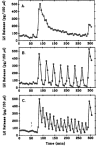

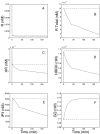
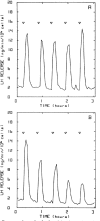

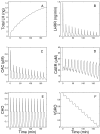
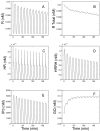
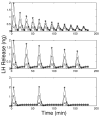







Similar articles
-
A mathematical model quantifying GnRH-induced LH secretion from gonadotropes.Am J Physiol Endocrinol Metab. 2000 Feb;278(2):E263-72. doi: 10.1152/ajpendo.2000.278.2.E263. Am J Physiol Endocrinol Metab. 2000. PMID: 10662710
-
Desensitization to gonadotropin-releasing hormone in perifused chicken anterior pituitary cells.Endocrinology. 1986 Oct;119(4):1510-8. doi: 10.1210/endo-119-4-1510. Endocrinology. 1986. PMID: 3093193
-
Regulation of luteinizing hormone release by pulsatile and continuous administration of gonadotropin-releasing hormone to superfused rat and hamster pituitary cells.Endocrinology. 1984 Mar;114(3):1041-7. doi: 10.1210/endo-114-3-1041. Endocrinology. 1984. PMID: 6365522
-
Dynamic characteristics of luteinizing hormone release from perifused sheep anterior pituitary cells stimulated by combined pulsatile and continuous gonadotropin-releasing hormone.Endocrinology. 1985 Jul;117(1):169-79. doi: 10.1210/endo-117-1-169. Endocrinology. 1985. PMID: 3891312
-
Ion Channels of Pituitary Gonadotrophs and Their Roles in Signaling and Secretion.Front Endocrinol (Lausanne). 2017 Jun 9;8:126. doi: 10.3389/fendo.2017.00126. eCollection 2017. Front Endocrinol (Lausanne). 2017. PMID: 28649232 Free PMC article. Review.
Cited by
-
Negative feedback governs gonadotrope frequency-decoding of gonadotropin releasing hormone pulse-frequency.PLoS One. 2009 Sep 29;4(9):e7244. doi: 10.1371/journal.pone.0007244. PLoS One. 2009. PMID: 19787048 Free PMC article.
-
Pulsatility of Hypothalamo-Pituitary Hormones: A Challenge in Quantification.Physiology (Bethesda). 2016 Jan;31(1):34-50. doi: 10.1152/physiol.00027.2015. Physiology (Bethesda). 2016. PMID: 26674550 Free PMC article. Review.
-
Molecular mechanisms of gonadotropin-releasing hormone signaling: integrating cyclic nucleotides into the network.Front Endocrinol (Lausanne). 2013 Nov 20;4:180. doi: 10.3389/fendo.2013.00180. Front Endocrinol (Lausanne). 2013. PMID: 24312080 Free PMC article. Review.
-
Pulsatile and sustained gonadotropin-releasing hormone (GnRH) receptor signaling: does the Ca2+/NFAT signaling pathway decode GnRH pulse frequency?J Biol Chem. 2009 Dec 18;284(51):35746-57. doi: 10.1074/jbc.M109.063917. J Biol Chem. 2009. PMID: 19858197 Free PMC article.
-
Decoding GnRH neurohormone pulse frequency by convergent signalling modules.J R Soc Interface. 2012 Jan 7;9(66):170-82. doi: 10.1098/rsif.2011.0215. Epub 2011 Jun 15. J R Soc Interface. 2012. PMID: 21676968 Free PMC article.
References
-
- Blum JJ, Reed MC, Janovick JA, Conn PM. A mathematical model quantifying GnRH-induced LH secretion from gonadotropes. Am J Physiol Endocrinol Metab. 2000;278:E263–E272. - PubMed
-
- Heinze K, Kenner RW, Midgley AR., Jr A Mathematical Model of Luteinizing Hormone Release fro Ovine Pituitary Cells in Perifusion. Am J Physiol. 1998;275:E1061–E1071. - PubMed
-
- Keenan DM, Sun W, Veldhuis JD. A stochastic biomathematical model of the male reproductive hormone system. SIAM J Appl Math. 2000;61:934–965. doi: 10.1137/S0036139998334718. - DOI
-
- Janovick JA, Conn PM. A cholera toxin-sensitive guanyl nucleotide binding protein mediates the movement of pituitary luteinizing hormone into a re-leasable pool: loss of this event is associated with the onset of homologous desensitization to gonadotropin-releasing hormone. Endocrinology. 1993;132:2131–2135. doi: 10.1210/en.132.5.2131. - DOI - PubMed
Publication types
MeSH terms
Substances
Grants and funding
LinkOut - more resources
Full Text Sources

